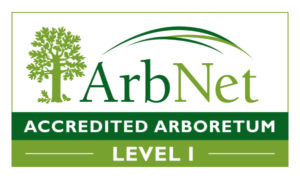Mount Moriah Cemetery is a Level 1 ArbNet Arboretum
Mount Moriah Cemetery encompasses just under 200 acres and is bisected by Cobbs Creek, part of the Darby-Cobbs Watershed, which flows to the Delaware River. This historic burial ground is also an urban green space that is enjoyed and revered by the living. We intend to preserve and protect the overall ecology and health of the existing ecosystem by 1) maintaining historic trees, 2) adding new tree plantings in keeping with the historic nature of the grounds, and 3) replacing invasive plant materials with native plantings.
Please help maintain this green space. Do not climb or attach anything to trees. Picking or cutting flowers from the grounds is not allowed.
The Tree Collection at Mount Moriah Cemetery and Arboretum is essential to maintaining the historic "rural" character of the cemetery and honors those who are buried within its hallowed grounds. As the restoration of the cemetery progresses, it is of the utmost importance to preserve and protect the overall health of the existing, functional ecosystems. Mount Moriah Cemetery’s varied tree species help to maintain the visual character of the cemetery, contribute to stormwater management, and provide a refuge for wildlife and human visitors in the dense urban fabric of Philadelphia and Delaware Counties.
ArbNet Level 1 Arboretum
Mount Moriah Cemetery received Level 1 certification from ArbNet in 2016.
In 2016, volunteers documented the various tree species throughout the cemetery using GPS methodology and a taxonomic database (master spreadsheet). At that time we identified and documented 86 trees (36 species).
In March 2021, three trees on the Yeadon side of the cemetery were measured and added to the PABigTrees.com Register:
- The English Yew, Taxus baccata, is #6 in PA, #1 in Delaware County
- Two Tulip Poplars are #14 and #15 in PA, #3 and #4 in Delaware County
 Also in 2021, we updated and confirmed the ID and locations of Mount Moriah Cemetery’s significant trees. Working with our collections list, researcher and volunteer Heather Kostick, PhD candidate and Teaching Assistant in the Department of Biodiversity, Earth, and Environmental Sciences (BEES) at Drexel University, completed an updated tree inventory in August, 2021.
Also in 2021, we updated and confirmed the ID and locations of Mount Moriah Cemetery’s significant trees. Working with our collections list, researcher and volunteer Heather Kostick, PhD candidate and Teaching Assistant in the Department of Biodiversity, Earth, and Environmental Sciences (BEES) at Drexel University, completed an updated tree inventory in August, 2021.
Ms. Kostick and her research assistants completed the survey, finalized the data, recorded findings in a new database file, and shared the findings with the FOMMC. Thanks to Heather and her team, we now have an updated list of just under 150 trees (51 species) that have been identified and located. A majority of the trees in our collection are native/indigenous to the eastern United States Mid-Atlantic region.
Photos: Heather Kostick, 2021

